
95% of researchers rate our articles as excellent or good
Learn more about the work of our research integrity team to safeguard the quality of each article we publish.
Find out more
ORIGINAL RESEARCH article
Front. Comput. Sci. , 04 August 2022
Sec. Human-Media Interaction
Volume 4 - 2022 | https://doi.org/10.3389/fcomp.2022.874841
This article is part of the Research Topic Social Networking Sites and Adjustment Problems in Offline and Online Contexts in Adolescence View all 10 articles
 Entesar Alaskari1
Entesar Alaskari1 Turki Alanzi1*
Turki Alanzi1* Saja Alrayes1
Saja Alrayes1 Duaa Aljabri1
Duaa Aljabri1 Salma Almulla2
Salma Almulla2 Demah Alsalman1
Demah Alsalman1 Areej Algumzi3
Areej Algumzi3 Rana Alameri4
Rana Alameri4 Zahraa Alakrawi1
Zahraa Alakrawi1 Norah Alnaim5
Norah Alnaim5 Latifa Almusfar6
Latifa Almusfar6 Leyan Alotaibi7
Leyan Alotaibi7 Linah Saraireh6
Linah Saraireh6 Razaz Attar8
Razaz Attar8 Amal Bakhshwain9
Amal Bakhshwain9 Afnan Almuhanna10
Afnan Almuhanna10 Duha AlSanad11
Duha AlSanad11 Fahad Alenazi6
Fahad Alenazi6 Hayat Mushcab12
Hayat Mushcab12 Nouf Alanezi13
Nouf Alanezi13 Naif Alenazi14
Naif Alenazi14Study purpose: It is important to understand the users' perceptions toward the use of smartwatches and the various factors that affect the adoption of smart watches. These findings would contribute to the literature in understanding users' usage, preferences, needs, and expectations about smartwatches that would aid smartwatches designers and also decision-makers in integrating the smartwatch technology in various service-enabled areas such a healthcare, e-learning etc. To address this gap, the objective of this study was formulated to understand the actual consumers' perceptions of toward the use of smartwatches and explore the critical factors affecting the adoption and intention to use smartwatches in the Kingdom of Saudi Arabia.
Methods: A cross-sectional study was designed to assess the actual perception of use smartwatches and to investigate the influencing factors that affect the utilization among Saudi population using the survey technique. Questionnaire design was based on the domains of Technology Acceptance Model (TAM) to determine the factors affecting smartwatches utilization. The sample composed of Saudi Arabian residents aged 18 years and above. The response rate for the online questionnaire that was distributed through the social media applications was 58.61% representing 135 participants. The data was collected in November 2020 and analyzed using the Statistical Packages for Software Sciences (SPSS).
Results: The prevalence of participants who had knowledge about smartwatch was 94.1%. When comparing the demographic characteristics between those owning and not owning a smartwatch, it was found that educational level (X2 = 9.365; p = 0.025) and knowledge about smartwatch (X2 = 7.897; p = 0.005) had significant relationship with owning a smartwatch. When comparing between design aesthetic, perceived usefulness, ease of use, enjoyment and healthology in relation to the socio demographic characteristics, it was found that respondents in the older age group (≥45 years) (F = 11.797; p<0.001) and those with master degree (F = 3.449; p = 0.002) observed to have significantly lower mean score in design aesthetic while females exhibited significantly higher score in perceived enjoyment and healthology (T = −3.629; p = 0.001) as well as design aesthetic (T = −2.070; p = 0.043).
Conclusion: Factors such as age, education, gender, income can significantly affect the adoption of wearable devices in Saudi Arabia.
In the past few years, new types of wearable technologies have been evolving, which are referred as wearable smart devices or simply wearable devices. The wearable devices can be defined as computing devices that has advanced electronics and communication technologies and can be worn by individuals, facilitating interaction between the users and a smart platforms. Furthermore, the wearable devices, especially smartwatches, are getting significant attention and huge investments by big smartphone companies (Apple, Samsung, LG, Google, etc.) which illustrate the evolving era of smartwatches (Dehghani et al., 2018).
The smart wearable device is one of the fastest growing markets globally. In 2012, smartwatches drew the attention when the Pebble Smartwatch was introduced on the crowdfunding website (Choi and Kim, 2016). In 2016, the International Data Corporation (IDC) anticipated that smartwatch market would substantially grow by 2020, estimating a market of $17.8 billion (Afrouz and Wahl, 2019).
The smartwatch is a wrist-worn device with a portable computer that can connect to other devices via short range wireless connectivity. In addition to having an integrated clock, the smartwatch can provide alert notifications, collect data via sensors and upload personal data in a 24 x 7 manner in an attempt to improve the quality of daily life (Seneviratne et al., 2017). Smartwatches have the advantage of connecting to the skin since they are wrist mounted which facilitate their wide use in the fields of sports and healthcare. Smartwatches could decrease consumer's attention given to other devices, such as smartphones, as important information is conveniently displayed on the user's wrist (Chuah et al., 2016).
In a recent study conducted in Germany (Afrouz and Wahl, 2019), it was identified that attitude toward using wearable technology was the strongest predictor for the intention to purchase smartwatches followed by Perceived Behavioral Control. The smartwatch can be used for various purposes such as navigation, financial payments, physical and mental health monitoring, sport analytics, and medical insurance analytics (Seneviratne et al., 2017). It is worth mentioning that most smartwatch producers have merged the technology and fashion in an attempt to attract more consumers (Chuah et al., 2016; Moore, 2016).
International reports predict an increased demand for smartwatches in the future while the current actual sales are relatively less than what is forecasted (Chuah et al., 2016). This difference implies that what influences the consumers to own smartwatches is not sufficiently known; especially that smartwatches technology is in the initial stages of its lifecycle. Therefore, more studies are needed to address this gap in the knowledge.
There have been various studies (Baudier et al., 2020; Scott, 2020) identified in the literature that focused on the adoption and use of smart devices. Various influencing the adoption of smart watches. Scott (Scott, 2020) has identified that privacy concerns is one of the major factors affecting the smart watches adoption in USA. A similar study (Scott, 2020) conducted in four developed countries including USA, UK, France, and Germany has found that age and gender factors moderately impact the adoption of smart watches. In addition, it was found that perceived ease of use had no impact on the adoption attitudes. However, in a study conducted in South Korea, found that perceived ease of use had a significant impact on the intention to use of smart watches (Baudier et al., 2020). Other, factors such as prior experience, affective quality and technology-related anxiety impacted the adoption of smart watches among the older adults (Choe and Noh, 2018). Similarly, another study (Lazaro et al., 2020) conducted in Malaysia identified four dimensions including perceived benefits, healthology, IT innovation, and smartwatch as luxury products which significantly influenced the adoption of smartwatches. Using a complex model smartwatches adoption among IT professionals was investigated in a study (Said et al., 2021) and it was found that self-efficacy, personal innovativeness, social media influence, social image, aesthetics and external social influence were major factors of influence. Similarly, various studies (Hsiao, 2017; Kranthi and Ahmed, 2018; Dutot et al., 2019; Pua, 2020; Visuri et al., 2021) identified different technical factors affecting the intention to use smart watches, while the behavioral and user-centered aspects were undermined.
As highlighted by Choia and Seongcheol (Choi and Kim, 2016), most academic studies on smartwatches have been driven by technology rather than audience. Thus, it is important to understand the users' perceptions toward the use of smartwatches and the various factors influencing the adoption of smartwatches. These findings would contribute to the literature in understanding users' usage, preferences, needs, and expectations that would aid smartwatches developers and also decision-makers in integrating the smartwatch technology in various service-enabled areas such as healthcare and e-learning. This study aims to understand the actual consumers' perceptions of using smartwatches and explore the critical factors influencing the intention to use smartwatches in the Kingdom of Saudi Arabia.
This is a cross-sectional study following the STROBE checklist for observational and cross-sectional studies (Equator-Network, 2021) that took place in November 2020. The study received the Institutional Review Board approval from Imam Abdulrahman Bin Faisal University, Saudi Arabia. The study follows the guidelines of Helsinki Declaration of 1975.
The questionnaire used was partially adopted from another study (Afrouz and Wahl, 2019) and contained 15 items to achieve the main objective of the study. The questionnaire was developed to measure the level of awareness, actual usage, and influencing factors to use smartwatches in the Kingdom of Saudi Arabia. Also, the questions were piloted before the actual use with the participants and the final questionnaire was confirmed clear and visible by two academic experts. In addition, the questionnaire was translated to Arabic language and validated using the back-and-forth translation process, and then distributed among Saudi targeted population.
Technology Acceptance Model (TAM) is one of the most used theoretical models to examine human behavior regarding potential acceptance or rejection of the new technology (Marangunić and Granić, 2014). This model helps to understand the individual's acceptance of new technologies or application. In this study we used eight domains of TAM which are Perceived ease of use (PE), Perceived usefulness (PU), Perceived Enjoyment and healthology (PEH), Design Aesthetic (DA), Attitude Toward Using (ATU), Subjective Norm (SN), Perceived Behavioral control (PBI) and Purchase Intention of use (PI).
The first five items in the questionnaire were obtaining demographic characteristics of the participants: gender, age, occupation, level of education, and monthly salary. Item 6 is dedicated to assess smartwatch awareness. Item 7 verifies the participants acquisition status of a smartwatch. Finally, items 8 to 15 are used, all items were measured on a 5-point Liker scale where 1 strongly disagree, 2 disagree, 3 neutral, 4 agree, and 5 is strongly agree. If the responses for item 7 is yes, then a set of having smartwatch questions were asked from item 8 to 11 to assess the perception of users toward the smartwatch utilization. If the responses for item 7 is no, then a set of don't own smartwatch questions were asked from item 12 to 15 to assess the perception of Saudi participants toward the smartwatch utilization.
The sample population size was constituted by Saudi citizens all over the kingdom of Saudi Arabia. The participants have provided their agreement to participate in the questionnaire of this. Participation is entirely voluntary, and the responses were anonymized.
All of the Saudi citizens aged 18 years and older, whether or not using a smartwatch, were considered eligible in this study. All other residents of other nationalities were excluded.
The questionnaire was distributed to the participants using online social media platforms and the data were collected from 14 to 29 November 2020. The survey link was forwarded to 231 participants through various social media channels including twitter, WhatsApp, Instagram, and Facebook. By the end of two-weeks, 135 responses were received indicating a response rate of 58.6%.
Categorical variables were presented as frequency and percentages (%) while continuous variables were presented as mean and standard deviation, whenever appropriate. Between comparisons of variables, Chi-square test, independent t-test and One-way ANOVA test were applied. Correlation procedures were also conducted to determine the linear agreement between Technology Acceptance Model domains. P ≤ 0.05 was considered statistically significant while p ≤ 0.01 were considered highly statistically significant. All data analysis was performed using the Statistical Packages for Software Sciences (SPSS) version 21, IBM Corporation.
A total of 135 responses were received to evaluate their use of wearable devices (smartwatch). As seen in Table 1, the most common age group was 35–44 years (40.7%) with more than a half (55.6%) were males and 46.7% had a bachelor's degree.
With regards to their occupational status, nearly two third (65.9%) were employed with 40.7% of them earned 10,001–20,000 SAR per month. The prevalence of participants who had information about smartwatch was 94.1% (Figure 1). When comparing the socio-demographic characteristics against owning a smartwatch. It was found that educational level (X2 = 9.365; p = 0.025) and knowledge about smartwatch (X2 = 7.897; p = 0.005) had significant association with owning a smartwatch.
The descriptive statistics of Technology Acceptance Model (TAM) subscales are shown in Table 2. Based on the results, the mean score of perceived usefulness, ease of use, enjoyment and healthology, and design aesthetic were 15.5, 17.4, 16.1, and 16, respectively (Figures 2, 3), while the mean score of attitudes toward using smartwatch, subjective norm, perceived behavioral control and purchase intention were 14.2, 10.4, 11.7, and 9.79, respectively (Figures 4, 5). With regards to reliability analysis, the Cronbach Alpha was higher on purchase intention domain (Cronbach Alpha: 0.964), followed by design aesthetic domain (Cronbach Alpha: 0.931) and attitude toward using smartwatch (Cronbach Alpha: 0.916) while perceived ease of use was the lowest (Cronbach Alpha: 0.717).
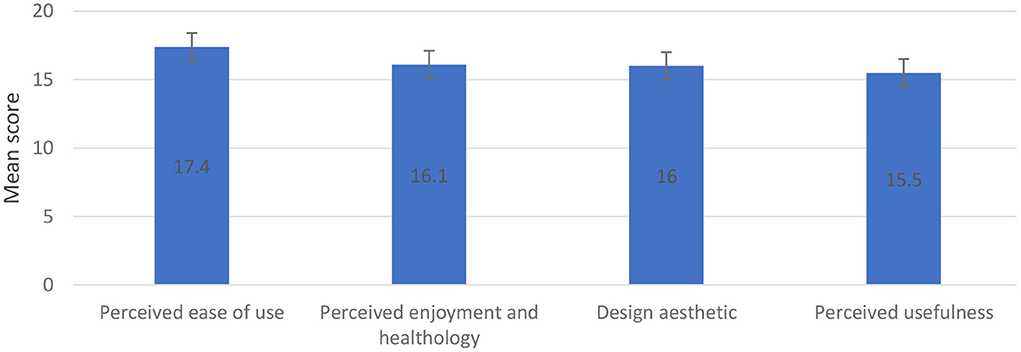
Figure 2. Mean distribution of design aesthetics perceived usefulness, ease of use, enjoyment and healthology.
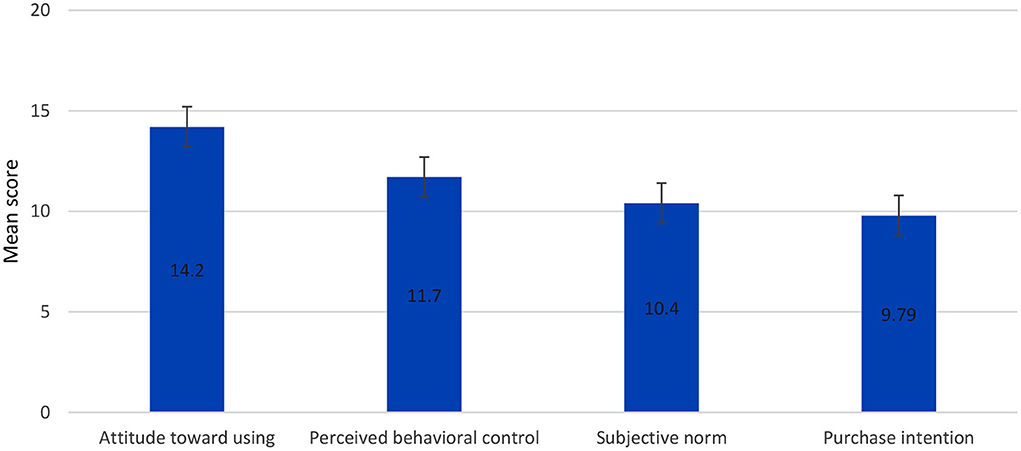
Figure 4. Mean distribution of attitude toward using, perceived behavioral control, subjective norm and purchase intention.

Figure 5. Explanation for each domain affects the customer who don't won smartwatch on Saudi Arabia.
Table 3 showed the correlation procedure between design perceived usefulness, ease of use, enjoyment and healthology. It revealed that the correlation between perceived usefulness, perceived ease of use, perceived enjoyment and healthology, and design aesthetic were positively highly statistically significant (p < 0.01).
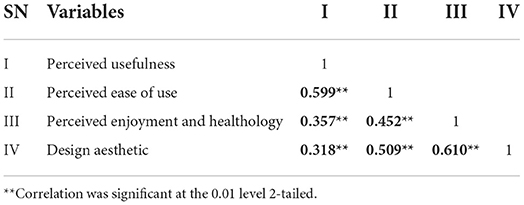
Table 3. Correlation (Pearson-R) between design aesthetic, perceived usefulness, ease of use, enjoyment and healthology.
In Table 4, the correlation between attitude toward using smartwatch, subjective norm, perceived behavioral control, and purchase intention had high statistical significance as well (p < 0.01).
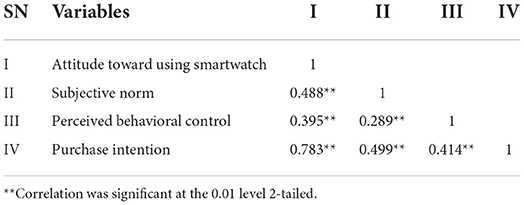
Table 4. Correlation (Pearson-R) between attitude toward using smartwatch, subjective norm, perceived behavioral control and purchase intention.
When comparing between design aesthetic, perceived usefulness, ease of use, and enjoyment and healthology in relation to the socio demographic characteristics (Table 5), it was found that respondents in the older age group (≥45 years) (F = 11.797; p < 0.001) and those with master degree (F = 3.449; p = 0.002) observed to have significantly lower mean score in design aesthetic while females exhibited significantly higher score in perceived enjoyment and healthology (T = −3.629; p = 0.001) as well as design aesthetic (T = −2.070; p = 0.043).
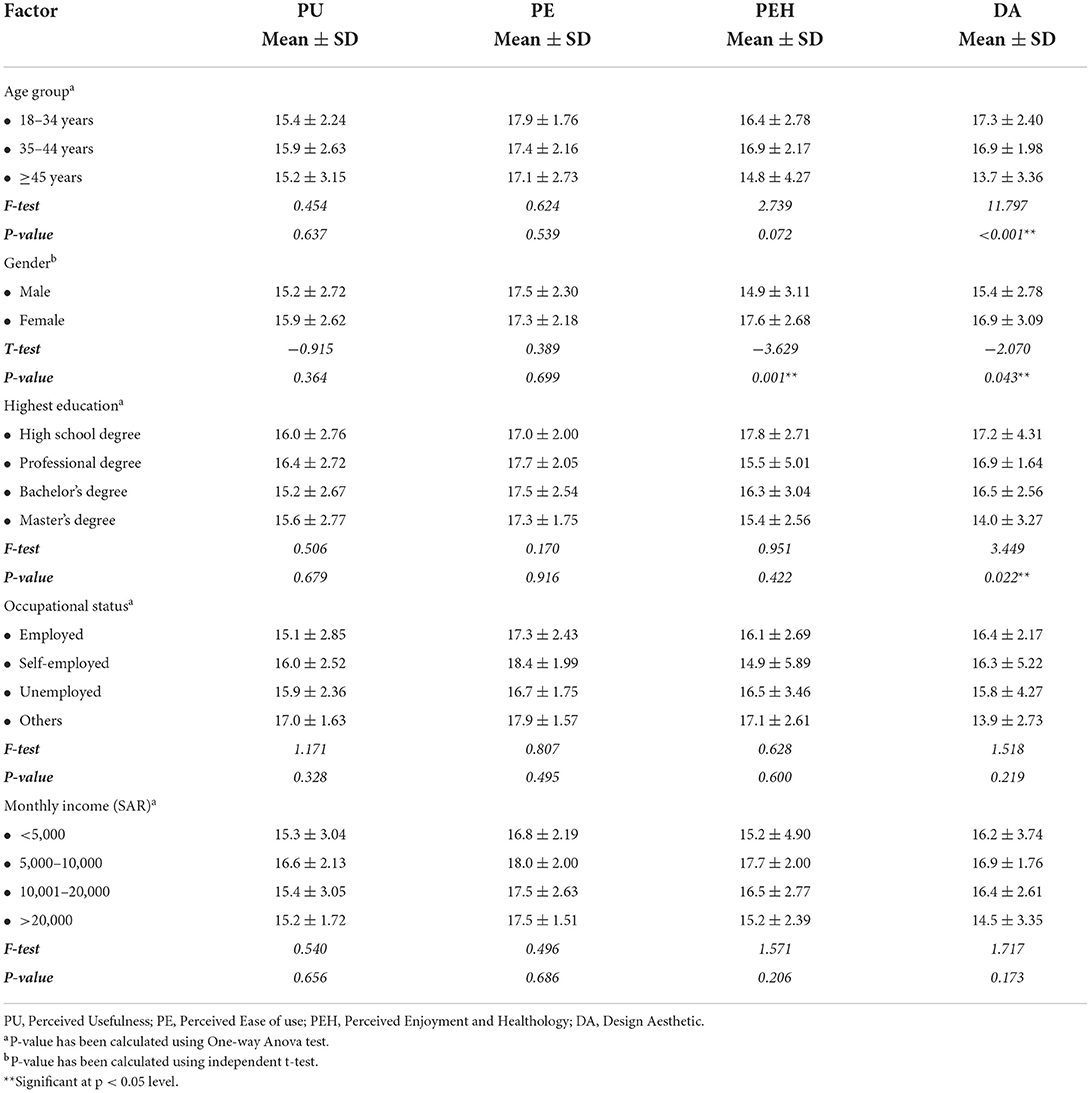
Table 5. Comparison between design aesthetic, perceived usefulness, ease of use, enjoyment and healthology in relation to the socio demographic characteristics of participants.
Table 6, shows that only occupational status showed significant difference with attitude toward the use of smartwatch with students exhibited significantly higher score compared to the other groups (F = 2.836; p = 0.031). Other socio demographic characteristics did not differ significantly when compared to attitude toward use, subjective norm, perceived behavioral control and purchase intention (all p > 0.05).

Table 6. Comparison between attitude toward using, subjective norm, perceived behavioral control and purchase intention in relation to the socio demographic characteristics of participants.
The purpose the study is to assess the actual perception of use of smartwatches and to investigate the influencing factors for utilizing them among Saudi population. This study enrolled 135 respondents to evaluates perception of the Saudi, regardless of owning a smartwatch or not, and their adoption intention toward this device. The findings of this study revealed that most Saudis, around 94%, have pre-existing knowledge about smart watches, approximately half (48%) of the Saudi who own smartwatch were: male (56.95%), had Bachelor's degree (55.4%), employed (66.2%) and their monthly income 10.000–20.000SR (44.6%). However, in a study conducted in Indonesia (Anggraini et al., 2019), it was identified that most respondents heard about smartwatches, half of them have a smartwatch and more than 70% of the remaining half don't have a smartwatch due to high price.
With regards to coefficient reliability during the study analysis, the reliability was higher in PI, followed gradually by DA, ATU, SN, BPI, PEH, PU, while PE was the lowest. This study revealed a strong association and positive relationship between the four domains: PU, PE, PEH and DA which were affected by the responder owning a smartwatch. It also showed strong association and positive correlation between the other four domains: ATU, SN. PBC, and PI which were affected by the responder who doesn't own a smartwatch among Saudi population. This is consistent with Hakroh et al.'s paper (Hokroh et al., 2020) where they investigated the association between: Heart Health (HH), Weight Management (WM), and Sleep Improvement (SI) as antecedents for Perceived Usefulness (PU). Also, Wearable Design (WD), Graphical User Interface (GUI) and Health Information Support (HIS) as antecedents for Perceived Ease of Use (PEU) as influences factors among Saudi population.
In this study, it is identified that Saudi citizens who own a smartwatch are usually highly educated and knowledgeable about smartwatches. Saudi users over the age of 45 as well as those with master degree level both observed with low interest in design aesthetic for smartwatches while female users had remarkable interest in perceived enjoyment and healthology as well as design aesthetic. According to Dehghani et al. (Dehghani et al., 2018) gender plays an important role in smartwatch adoption intention and actual usage. Most of smartwatches companies don't pay attention to the aesthetic features but they focus on technology features in designs. Furthermore, Companies need to consider marketing pending on the customer needs, gender and different setting. In a study conducted in Taiwan (Hsiao, 2017), it was identified that perceived product contributes effectively on adoption intention of smartwatches.
Moreover we observed that Saudi students who don't own a smartwatch showed positive attitude toward the use of smartwatch technology, in other words, student believe that using a smartwatch is a good decision compared to the other occupational status groups. In a study (Arpaci et al., 2021) conducted in Malaysia, machine learning techniques were applied in assessing the adoption and it was the first study to gather a novel assistance to the information systems (IS) literature by assessing the student behavioral intention for adoption of wearable technologies (smartwatch).
The total number of participants in the study was only 135, which is considered a key limitation therefore, the generalization of findings in this study must be done with care by future researchers. In addition, this study focused on smartwatches in general. However, the functionalities of the smartwatches may vary with the brand, their purpose, features and functionalities. Therefore, our findings may not be applicable to all types of smartwatches. However, researchers can develop many future research projects from this study. The study can be taken forward in a larger scale with the use of mixed-methods such as interviews and surveys for in-depth analysis of the results. In addition, the future studies may focus on comparing the users' perceptions, adoption, and intention to use according to the smartwatches analyzed by brand, functions and features, and purpose.
Finally, our study carries both practical and theoretical implications. The findings from this study, such as the usage behavior of males vs. females; younger vs. older population; married vs. single; highly educated vs. low educated. can help in understanding the users' perceptions among the different groups, which can help the designers and developers of smartwatches in developing the devices according to the users' expectations and can streamline their marketing strategy by targeting a specific group of customers. Most importantly, our study contributes to enriching the knowledge gap in the literature about the users' perceptions, use, and adoption of smartwatches in the Middle East, and contributes significantly in understanding the users' preferences and adoption traits in this region, which can serve as a reference for future work in this domain.
Nowadays, Wearable's are becoming more mercantile and used among customers all over the world. Smartwatches are the most popular wearable's device known by most of the population. This study found the actual consumers' perceptions of smartwatch utilization in kingdom of Saudi Arabia, using TAM show the significant relationship between the 8 domains: PU, PE. PEH, DA, ATU, SN, PBC, and PI that used to determine the smartwatches acceptance among the Saudi population whether they own a smartwatch or not. These domains are considered as effective factors toward smartwatch utilization to provide wearable devices designed according to the user's preferences and needs. Finally, we can say, perceived product contributes effectively on adoption intention of smartwatches. Further related research is needed in order to further explore the influential factors for adoption intention, that were found to be significant in this study, for the sake of better understanding of consumers' needs.
The raw data supporting the conclusions of this article can be provided by the authors upon request without undue reservation.
The studies involving human participants were reviewed and approved by the Institution Review Board (IRB) at Imam Abdulrahman bin Faisal University. The patients/participants provided their written informed consent to participate in this study.
All authors listed have made a substantial, direct, and intellectual contribution to the work and approved it for publication.
Author DuA is an employee of Saudi Aramco. Author HM is an employee of Johns Hopkins Aramco Healthcare.
The remaining authors declare that the research was conducted in the absence of any commercial or financial relationships that could be construed as a potential conflict of interest.
All claims expressed in this article are solely those of the authors and do not necessarily represent those of their affiliated organizations, or those of the publisher, the editors and the reviewers. Any product that may be evaluated in this article, or claim that may be made by its manufacturer, is not guaranteed or endorsed by the publisher.
Afrouz, M. M., and Wahl, T. (2019). Wearable Technologies: Factors That Influence the Purchase Intention of Smartwatches in Germany. Jonkoping University. Available at: http://www.diva-portal.org/smash/get/diva2, 1319726./FULLTEXT01.pdf (accessed: 15 June, 2021).
Anggraini, N., Kaburuan, E., Wang, G., and Jayadi, R. (2019). Usability study and users' perception of smartwatch: study on indonesian customer. Procedia Comput Sci. (2019) 161:1266–1274. doi: 10.1016/j.procs.11, 241.
Arpaci, I., Al-Emran, M., Al-Sharafi, M. A., and Shaalan, K. (2021). “A novel approach for predicting the adoption of smartwatches using machine learning algorithms,” in Recent Advances in Intelligent Systems and Smart Applications. Studies in Systems, Decision and Control, Vol. 295, eds Al-Emran, M., Shaalan, K., and Hassanien (Cham: Springer). doi: 10.1007/978-3-030-47411-9_10
Baudier, P., Ammi, C., and Wamba, S. (2020). Differing perceptions of the smartwatch by users within developed countries. J Glob Inf Manag. 28, 1–20. doi: 10.4018/JGIM.2020100101
Choe, M. J., and Noh, G. Y. (2018). Combined model of technology acceptance and innovation diffusion theory for adoption of smartwatch. Int J Contents. 14, 32–38. doi: 10.5392/IJoC.2018.14.3.032
Choi, J., and Kim, S. (2016). Is the smartwatch an IT product or a fashion product? A study on factors affecting the intention to use smartwatches. Comp Human Behavior. 63:777–786. doi: 10.1016/j.chb.06, 007.
Chuah, S., Rauschnabel, P., Krey, N., Nguyen, B., Ramayah, T., Lade, S., et al. (2016). Wearable technologies: the role of usefulness and visibility in smartwatch adoption. Comput Human Behav. 65, 276–284. doi: 10.1016/j.chb.07, 047.
Dehghani, M., Kim, K., and Dangelico, R. (2018). Will smartwatches last? Factors contributing to intention to keep using smart wearable technology. Telematics and Informatics. (2018) 35:480–490. doi: 10.1016/j.tele.01, 007.
Dutot, V., Bhatiasevi, V., and Bellallahom, N. (2019). Applying the technology acceptance model in a three-countries study of smartwatch adoption. J High Technol Manag Res. (2019) 30:1–14. doi: 10.1016/j.hitech.02, 001.
Equator-Network (2021). STROBE Statement–checklist of items that should be included in reports of observational studies. Equator-network.org. 2021. Available online at: https://www.equator-network.org/wp-content/uploads/2015/10/STROBE_checklist_v4_combined.pdf (accessed July 18, 2022).
Hokroh, M., Green, G., and Soelton, M. (2020). Factors influencing health wearables adoption and usage in Saudi Arabia. J Technol Manag Innov. 1, 33–42. doi: 10.26677/TR2020, 604.
Hsiao, K. L. (2017). What drives smartwatch adoption intention? Comparing Apple and non-Apple watches. Library Hi Tech. 35, 186–206. doi: 10.1108/LHT-09-2016-0105
Kranthi, A., and Ahmed, K. (2018). Determinants of smartwatch adoption among IT professionals - an extended UTAUT2 model for smartwatch enterprise. Int J Enterprise Network Manag. 9, 294. doi: 10.1504/IJENM.2018.094669
Lazaro, M., Lim, J., Kim, S., and Yun, M. (2020). Wearable technologies: acceptance model for smartwatch adoption among older adults. In: Human Aspects of I. T. for the Aged Population, Technologies Design and User Experience. p. 303–15. doi: 10.1007./978-3-030-50252-2_23
Marangunić, N., and Granić, A. (2014). Technology acceptance model: a literature review from 1986 to 2013. Univers Access Inf Soc. 14, 81–95. doi: 10.1007/s10209-014-0348-1
Moore, S. (2016). Gartner Survey Shows Wearable Devices Need to Be More Useful. Gartner. Available online at: https://www.gartner.com/en/newsroom/press-releases/2016-12-07-gartner-survey-shows-wearable-devices-need-to-be-more-useful (accessed July 18, 2022).
Pua, M. H. J. T. (2020). Status-quo satisfaction and smartwatch adoption: a multi-group analysis. Ind Manag Data Syst. 120, 2319–2347. doi: 10.1108/IMDS-10-2019-0576
Said, N., Abu Seman, S., and Ab Latiff, D. (2021). Ma'o S, Mohamad Mozie N. Consumers' behavioral intention towards smartwatch adoption in malaysia: a concept paper international. J Innovative Comput. 11, 13–19. doi: 10.11113/ijic.v11n1.281
Scott, D. A. (2020). A Correlation Study of Smartwatch Adoption and Privacy Concerns with U.S. Consumers Using the UTAUT2. Dissertation, Colorado Technical University, 2020. Available online at: https://www.proquest.com/openview/bf2acb7ddb06f4e9867652fce3125ee2/1?pq-origsite=gscholarandcbl=18750anddiss=y (accessed 15 June, 2021).
Seneviratne, S., Hu, Y., Nguyen, T., Lan, G., Khalifa, S., Thilakarathna, K., et al. (2017). A Survey of wearable devices and challenges. IEEE Commun Surveys Tutorials. 19, 2573–2620. doi: 10.1109/COMST.2017.2731979
Keywords: wearable technology, smartwatch, Saudi Arabia, utilization and application, healthcare
Citation: Alaskari E, Alanzi T, Alrayes S, Aljabri D, Almulla S, Alsalman D, Algumzi A, Alameri R, Alakrawi Z, Alnaim N, Almusfar L, Alotaibi L, Saraireh L, Attar R, Bakhshwain A, Almuhanna A, AlSanad D, Alenazi F, Mushcab H, Alanezi N and Alenazi N (2022) Utilization of wearable smartwatch and its application among Saudi population. Front. Comput. Sci. 4:874841. doi: 10.3389/fcomp.2022.874841
Received: 27 March 2022; Accepted: 27 June 2022;
Published: 04 August 2022.
Edited by:
Gonzalo Musitu Ochoa, Universidad Pablo de Olavide, SpainReviewed by:
Christos Troussas, University of West Attica, GreeceCopyright © 2022 Alaskari, Alanzi, Alrayes, Aljabri, Almulla, Alsalman, Algumzi, Alameri, Alakrawi, Alnaim, Almusfar, Alotaibi, Saraireh, Attar, Bakhshwain, Almuhanna, AlSanad, Alenazi, Mushcab, Alanezi and Alenazi. This is an open-access article distributed under the terms of the Creative Commons Attribution License (CC BY). The use, distribution or reproduction in other forums is permitted, provided the original author(s) and the copyright owner(s) are credited and that the original publication in this journal is cited, in accordance with accepted academic practice. No use, distribution or reproduction is permitted which does not comply with these terms.
*Correspondence: Turki Alanzi, dGFsYW56aUBpYXUuZWR1LnNh
Disclaimer: All claims expressed in this article are solely those of the authors and do not necessarily represent those of their affiliated organizations, or those of the publisher, the editors and the reviewers. Any product that may be evaluated in this article or claim that may be made by its manufacturer is not guaranteed or endorsed by the publisher.
Research integrity at Frontiers

Learn more about the work of our research integrity team to safeguard the quality of each article we publish.